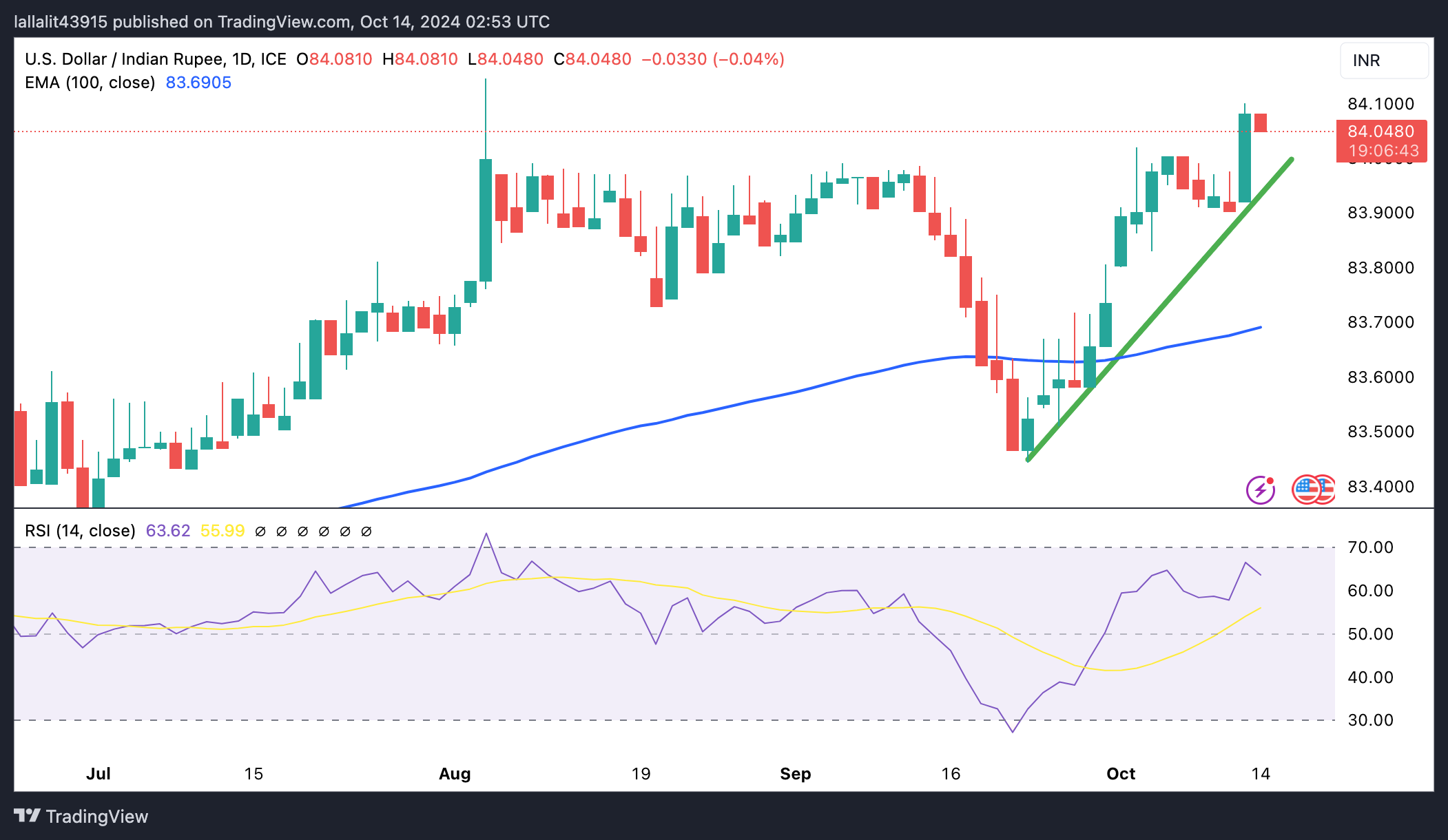USD/INR weakens ahead of Indian WPI inflation data
- The Indian Rupee drifts higher in Monday’s Asian session.
- Elevated oil prices and sustained outflows from local stocks weigh on the INR; RBI intervention might help limit its losses.
- India’s Wholesale Price Index (WPI) inflation data will take center stage on Monday.
The Indian Rupee (INR) recovers some lost ground on Monday after retreating to an all-time low in the previous session. The concerns about the recent spike in oil prices amid geopolitical tensions, significant foreign investor sell-offs from the equity market and higher demand for the greenback from foreign banks undermine the local currency.
Nonetheless, the likely intervention from the Reserve Bank of India (RBI) by US Dollar sales from state-run banks might cap the downside for the INR. Traders will keep an eye on India’s Wholesale Price Index (WPI) Inflation on Monday, which is expected to rise to 1.90% YoY in September from 1.31% in August. On the US docket, the NY Empire State Manufacturing Index for October will be released.
Daily Digest Market Movers: Indian Rupee recovers, potential upside seems limited
- “Indian Rupee fell below the 84 per US Dollar mark for the first time on demand from foreign banks amid FII outflows and elevated crude oil prices. Weak domestic markets also weighed on the Rupee,” said Anuj Choudhary, Research Analyst, Sharekhan by BNP Paribas.
- The annual PPI rose 1.8% YoY in September, compared to a 1.9% increase seen in August, and came in above the market expectation of 1.6%. The core PPI climbed 2.8% YoY in the same period, surpassing analysts' forecast of 2.7%.
- On a monthly basis, the US PPI was unchanged in September, while the core PPI was up 0.2% during the same period.
- The preliminary reading of the US University of Michigan Consumer Sentiment Index fell to 68.9 in October from 70.1 in September, below the consensus of 70.8. The 5-year consumer inflation expectations came in at 3.0% in September.
- The swaps markets show the Fed’s odds for a 25 bps rate cut at 95.6%, up from 83.3% before the PPI data, according to the CME FedWatch Tool.
Technical Analysis: USD/INR’s broader trend remains constructive
The Indian Rupee trades in positive territory on the day. The positive view of the USD/INR pair remains intact as the pair is still above the ascending trend line and the key 100-day Exponential Moving Average (EMA) on the daily timeframe. Additionally, the 14-day Relative Strength Index (RSI) is located above the midline near 64.20, hinting that the uptrend is more likely to gain traction than reverse.
The first upside barrier of USD/INR emerges near the all-time high of 84.15. A continuation of the climb past this level could pave the way for a test of 84.50.
On the flip side, the resistance-turned-support level at 83.90 acts as an initial support level for the pair. A breach of the mentioned level could see a drop to the 100-day EMA at 83.69, followed by 83.00, representing the round mark and the low of May 24.

Indian Rupee FAQs
The Indian Rupee (INR) is one of the most sensitive currencies to external factors. The price of Crude Oil (the country is highly dependent on imported Oil), the value of the US Dollar – most trade is conducted in USD – and the level of foreign investment, are all influential. Direct intervention by the Reserve Bank of India (RBI) in FX markets to keep the exchange rate stable, as well as the level of interest rates set by the RBI, are further major influencing factors on the Rupee.
The Reserve Bank of India (RBI) actively intervenes in forex markets to maintain a stable exchange rate, to help facilitate trade. In addition, the RBI tries to maintain the inflation rate at its 4% target by adjusting interest rates. Higher interest rates usually strengthen the Rupee. This is due to the role of the ‘carry trade’ in which investors borrow in countries with lower interest rates so as to place their money in countries’ offering relatively higher interest rates and profit from the difference.
Macroeconomic factors that influence the value of the Rupee include inflation, interest rates, the economic growth rate (GDP), the balance of trade, and inflows from foreign investment. A higher growth rate can lead to more overseas investment, pushing up demand for the Rupee. A less negative balance of trade will eventually lead to a stronger Rupee. Higher interest rates, especially real rates (interest rates less inflation) are also positive for the Rupee. A risk-on environment can lead to greater inflows of Foreign Direct and Indirect Investment (FDI and FII), which also benefit the Rupee.
Higher inflation, particularly, if it is comparatively higher than India’s peers, is generally negative for the currency as it reflects devaluation through oversupply. Inflation also increases the cost of exports, leading to more Rupees being sold to purchase foreign imports, which is Rupee-negative. At the same time, higher inflation usually leads to the Reserve Bank of India (RBI) raising interest rates and this can be positive for the Rupee, due to increased demand from international investors. The opposite effect is true of lower inflation.



